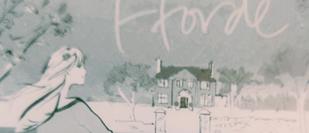
Coming Home by Rosamund Pilcher
In the UK at the moment there is a real feeling of Spring and the end of winter. March, at the moment has 'come in like a lion' which I hope means it goes out 'like a lamb'. More hopeful is the promise of the end of lockdown. At the time of writing Easter is close by and one of my good friends is expecting lambs in the next couple of weeks. Well not her obviously! but her flock of sheep.
All of this 'I wandered lonely as a cloud' musing brings me to my latest read which I read as part of my Rosamund Pilcher seasons readalong over on Instagram. The idea of our readalong is that we read a Rosamunde Pilcher book for each of the 4 seasons. The schedule looks something like this.
- Spring - Coming Home (discussion 31st March)
- Summer - The Shell Seekers (discussion 30th June)
- Autumn - September (discussion 20th September)
- Winter - Winter Solstice (discussion 31st December)
The group is lovely and all big fans of Rosamunde Pilcher and we have been sharing lots of pictures as well as casting for films of the books. As it is Spring, it is the turn of Coming Home published in 1995.
I've also put together a list of all Rosamunde Pilcher novels.
Plot
Coming Home can best be described as a real family saga. Set in the 1930s, Judith Dunbar's parents are moving to Singapore leaving Judith to go to boarding school. At school she becomes friends with Loveday Carey-Lewis and visits her family estate, Nancherrow. There she meets and falls in love with the Carey-Lewis family. She also encounters first love with Loveday's brother, Edward.
But war is approaching and Judith must leave Nancherrow. She is eager to contribute to the war effort, especially while waiting for news of her beloved family, who were in the area when Singapore fell. Will Judith see her family again? Will she return to Nancherrow? And what does Coming Home mean to the Carey-Lewis family and their assorted friends?
Themes
I'm not entirely sure why I feel this is a Spring book, but whenever I imagine this book, I always see Spring days, fresh winds and daffodils.
Essentially I see this book as being divided into two main parts; pre-war with all of the build up and establishment of all the characters, and the second part is about the war itself, the fight at home and abroad. The pacing is different, pre-war moves along at a languid pace, but the book picks up speed in the second half as the years roll by.
As with the other Pilcher works I have read, art and landscape remain a constant theme throughout the book. There are beautiful paintings on display at Nancherrow, Gus is an artist immortalising the family in his pictures. The final scenes of the first part, on the eve of War, are described as if they were a painting. A painting called 'The Tennis Party' where the family all gather in the garden, lazing around with a G&T and looking toothsome. It is a moment never to be repeated and indeed the family and friends will never be all together again.
Gus remembers a painting he was immensely fond of depicting a girl standing on the edge of a cliff, looking out to see, her hair blowing in the wind. And it is this image which he hangs onto throughout the book.
Cornwall is described beautifully and made me want to visit. Loveday cannot bear to leave Cornwall and the family's love for this place shines through. Other locations in the book are bleak and cold; Aunt Louise's home Windyridge and Biddy's home. But the sun always shines on Cornwall, fresh washing is hung out and Nancherrow is a warm, loving place.
The Characters
Whilst it is Judith and the Carey-Lewis's who are central to the story, it is pleasing that not all the action is wholly centred on them. Judith is a girl who has been forced to grow up quickly with being left in England, but she definitely has her head screwed on! One of our group asked if this was realistic, and I realised that I take a lot on faith that this was how people behaved. Judith is not prone to tears or hysterics but instead is sensible, calm and wise beyond her years.
I find Diana Carey-Lewis fascinating. She is stunning and enjoys nothing more than a house full of guests. Whilst devoted to her husband, who is considerably older than she is, she still need to take time in London, dancing and shopping. Indeed it is Judith who describes the female Carey-Lewis's as lighting up a room and leaving it dimmer when they leave.
The most interesting character for me is Gus. Gus has never felt he fitted in due to his class, until he meets Edward. He is a serious man, loves engineering but his passion is art which he is immensely talented at.
Coming Home
Coming Home is definitely a big theme running through the book, but for me is most central for Judith and Gus. Judith has never really had solid roots. She is waiting for when her mother will go abroad, staying at school instead and staying with Aunts or friends during the school holidays. And then she discovers Nancherrow, is given her own room there and treated like an extra daughter. When she has to leave it is heartbreaking and she spends her time living all over the world working for the war effort.
For Gus, the ending is sublime because he is finally at home and at peace after the ravages of war. His home is not a place but a person.
My Thoughts
I have loved reading this again and as ever remain so impressed with Rosamunde Pilcher's writing. There are moments that occur that truly feel like a punch to the solar plexus.
Billy Fawcett is an utterly terrifying character, especially to the young Judith and her fear made the hairs stand up on the back of my neck.
It is fascinating to hear about work done during the war, especially through Judith;'s experiences in London and then abroad.
This is a well-written family saga that is absorbing in its attention to detail. I read this novel slowly and savoured every word. Please do not be put off by the size of the book, you will read this quickly. It's marvellous and I have hesitation in awarding this five stars.




